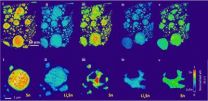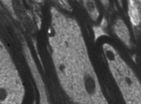(Press-News.org) Field studies covering three continents show that temperature has an unexpectedly important effect on food-web structure, while the relationship between predator and prey is crucial for the food-web dynamics and thereby the entire ecosystem.
Temperature is decisive
'We have gathered data on all animals and plants characterising the arctic tundra in seven different areas. This has allowed us to generate a picture of how food chains vary over a very large geographical (and, with it, climatic) gradient. Therefore, and for the first time, we can offer an explanation of the factors governing the tundra as an ecosystem,' says Niels Martin Schmidt from Aarhus University, Denmark, one of the researchers behind the study.
The researchers have evidenced that temperature is of decisive importance for which elements form part of the food chain, thus permitting them to predict how climate changes may impact whole food chains – and not just the conditions for the individual species.
The largest avoids being eaten
Temperature regulates which organisms interact with each other in the far north arctic nature. However, the present study also shows that predation, i.e. the interactions between predators and prey, is the factor regulating the energy flows in ecosystems and, with that, the function of the ecosystem.
'Our results show that predators are the most important items of the tundra food chains, except in the High Arctic. The intensity varies with the body size of the herbivores (plant eaters) of the chains. For example, the musk ox is far more likely to avoid being eaten by predatory animals than the lemming,' Niels Martin Schmidt explains.
Researchers have previously revealed similar patterns for the food chains of the African savannas. The researchers behind the present recently published study therefore believe that we may possibly be one step closer to proposing a general principle for how terrestrial ecosystems are structured.
INFORMATION:
Facts about the project
Collecting data for the project took place at seven locations in Canada, Greenland, Russia and Norway.
Nine research nations were involved in the project, which was launched under the title 'The International Polar Year' (2007–2009).
Based on the data collection, the researchers prepared models of the food net, which show the flow of energy and nutrients.
Facts about the tundra
The tundra is a habitat found in the far north of North America, Europe and Asia.
The word tundra comes from the Sami expression tūndar, which means 'flat hill', and the tundra countryside is characterised by shrubs and mosses, rather than large trees.
The tundra is inhabited by predators that prey on hares and small rodents in particular. Breeding migratory birds visit the tundra in summer, while the bird life is more scarce in winter.
For more information, please contact:
Senior Scientist Niels Martin Schmidt
Department of Bioscience and Arctic Research Centre
Aarhus University, Denmark
nms@dmu.dk
+45 4191 5664
Read more: Arctic ecosystem structure and functioning shaped by climate and herbivore body size in Nature Climate Change (published online 23 March 2014). http://www.nature.com/nclimate/journal/vaop/ncurrent/full/nclimate2168.html
Researchers reveal the dynamics behind Arctic ecosystems
The climate -- combined with the body size of the herbivores -- is crucial for how the tundra's ecosystem works
2014-03-27
ELSE PRESS RELEASES FROM THIS DATE:
IRCM researchers uncover a new function for an important player in the immune response
2014-03-27
Montréal, March 27, 2014 – IRCM researchers led by Javier M. Di Noia, PhD, uncovered a new function of AID, a crucial enzyme for the immune response. The discovery, recently published by the scientific journal Proceedings of the National Academy of Sciences (PNAS), helps explain a rare genetic disorder that causes an immunodeficiency syndrome.
The Montréal research team studies the enzyme AID, or activation-induced deaminase, that can be found in B lymphocytes (the group of white blood cells whose main function is to produce antibodies to fight against infections). AID ...
Scientists track 3-D nanoscale changes in rechargeable battery material during operation
2014-03-27
UPTON, NY-Scientists at the U.S. Department of Energy's Brookhaven National Laboratory have made the first 3D observations of how the structure of a lithium-ion battery anode evolves at the nanoscale in a real battery cell as it discharges and recharges. The details of this research, described in a paper published in Angewandte Chemie, could point to new ways to engineer battery materials to increase the capacity and lifetime of rechargeable batteries.
"This work offers a direct way to look inside the electrochemical reaction of batteries at the nanoscale to better understand ...
Dentist shortage bites California as more choose to practice out of state
2014-03-27
A lingering recession, the elimination of Medicaid dental reimbursements and a glut of established dentists in wealthier, populated areas may explain why more new dentists are practicing outside California, according to a new policy brief from the UCLA Center for Health Policy Research.
"Good access to dental care depends on having a robust supply of new dentists in California," said Nadereh Pourat, director of research at the center and lead author of the study. "We need a new generation of dentists to replace the many dentists who are close to retirement." ...
Decline of natural history troubling for science, society
2014-03-27
Support for natural history – the study of organisms, how and where they live and how they interact with their environment – appears to be in steep decline in developed countries, according to Joshua Tewksbury, a University of Washington professor and WWF International scientist.
"Yet natural history provides essential knowledge for fields as varied as human health, food security, conservation, land management and recreation," he said.
Tewksbury and 16 other scientists from across North America outline the importance to society and call for a revitalization of the practice ...
Big data keeps complex production running smoothly
2014-03-27
Large amounts of data are produced when industrial companies monitor their facilities. Sensors check temperature, pressure, power, or energy use data. "If you're scanning to the nearest second, it's easy to rack up several terabytes of information in under a week," says Dr. Olaf Sauer from the automation business unit at the IOSB. But often there is a lack of suitable methods to evaluate the information. "Today's operators use only about seven percent of this data for maintenance or protection from breakdowns," adds Sauer. At the Hannover Messe Digital Factory, IOSB developers ...
One size does not fit all: Dietary guidelines for choline may be insufficient
2014-03-27
What is now considered to be the "right" amount of the essential nutrient, choline, might actually be "wrong," depending on who you are. That's because scientists have found that the "right" amount of choline needed by an individual is influenced by a wide range of factors, including gender, life stage, race and ethnicity of the individual. This means that using the current one-size-fits-all approach to determining a person's vitamin and mineral needs may leave them in less than optimal health. Choline is an essential nutrient used by the body to construct cell membranes ...
First sightings of solar flare phenomena confirm 3D models of space weather
2014-03-27
Scientists have for the first time witnessed the mechanism behind explosive energy releases in the Sun's atmosphere, confirming new theories about how solar flares are created.
New footage put together by an international team led by University of Cambridge researchers shows how entangled magnetic field lines looping from the Sun's surface slip around each other and lead to an eruption 35 times the size of the Earth and an explosive release of magnetic energy into space.
The discoveries of a gigantic energy build-up bring us a step closer to predicting when and where ...
Military men more distressed by sexual harassment than military women, research finds
2014-03-27
WASHINGTON – Military men who are targets of frightening and threatening sexual harassment may experience more distress and work performance problems than military women who face the same treatment, according to research published by the American Psychological Association.
A total of 52 percent of military women said they had been sexually harassed compared with 19 percent of military men, and women more frequently reported they were very frightened by the experience than their male colleagues, according to a study published online in APA's Journal of Occupational Health ...
Gen X obesity a major problem for healthcare, workforce
2014-03-27
Researchers at the University of Adelaide have confirmed that if current trends continue, Australia's Generation X will overtake Baby Boomers for poor health, including rates of obesity and diabetes, which could have huge implications for healthcare and the workforce.
In a paper published in the online journal PLOS ONE, University of Adelaide researchers compared the health status of Baby Boomers (born from 1946–1965) and Generation X (1966–1980) at the same age range of 25-44 years.
They found Generation X had significantly poorer levels of self-rated health, and higher ...
Kaixin Jieyu Fang for treatment of vascular depression
2014-03-27
The Chinese compound Kaixin Jieyu Fang can be used to treat vascular depression; however, the underlying mechanism remains unclear. Dr. Ying Zhang and co-workers from Guang'anmen Hospital, China Academy of Chinese Medical Sciences in China This study established a rat model of chronic cerebral ischemia-caused white matter damage by ligation of the bilateral common carotid arteries. Rats received daily intragastric administration of a suspension of Kaixin Jieyu Fang powder. Kaixin Jieyu Fang was made from two prescriptions of Kaixin San and Sini San supplemented with Radix ...
LAST 30 PRESS RELEASES:
Numbers in our sights affect how we perceive space
SIMJ announces global collaborative book project in commemoration of its 75th anniversary
Air pollution exposure and birth weight
Obstructive sleep apnea risk and mental health conditions among older adults
How talking slows eye movements behind the wheel
The Ceramic Society of Japan’s Oxoate Ceramics Research Association launches new international book project
Heart-brain connection: international study reveals the role of the vagus nerve in keeping the heart young
Researchers identify Rb1 as a predictive biomarker for a new therapeutic strategy in some breast cancers
Survey reveals ethical gaps slowing AI adoption in pediatric surgery
Stimulant ADHD medications work differently than thought
AI overestimates how smart people are, according to HSE economists
HSE researchers create genome-wide map of quadruplexes
Scientists boost cell "powerhouses" to burn more calories
Automatic label checking: The missing step in making reliable medical AI
Low daily alcohol intake linked to 50% heightened mouth cancer risk in India
American Meteorological Society announces Rick Spinrad as 2026 President-Elect
Biomass-based carbon capture spotlighted in newly released global climate webinar recording
Illuminating invisible nano pollutants: advanced bioimaging tracks the full journey of emerging nanoscale contaminants in living systems
How does age affect recovery from spinal cord injury?
Novel AI tool offers prognosis for patients with head and neck cancer
Fathers’ microplastic exposure tied to their children’s metabolic problems
Research validates laboratory model for studying high-grade serous ovarian cancer
SIR 2026 delivers transformative breakthroughs in minimally invasive medicine to improve patient care
Stem Cell Reports most downloaded papers of 2025 highlight the breadth and impact of stem cell research
Oxford-led study estimates NHS spends around 3% of its primary and secondary care budget on the health impacts of heat and cold in England
A researcher’s long quest leads to a smart composite breakthrough
Urban wild bees act as “microbial sensors” of city health.
New study finds where you live affects recovery after a hip fracture
Forecasting the impact of fully automated vehicle adoption on US road traffic injuries
Alcohol-related hospitalizations from 2016 to 2022
[Press-News.org] Researchers reveal the dynamics behind Arctic ecosystemsThe climate -- combined with the body size of the herbivores -- is crucial for how the tundra's ecosystem works






